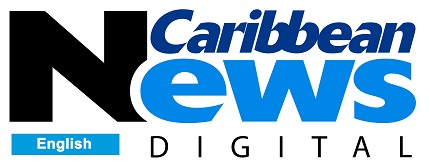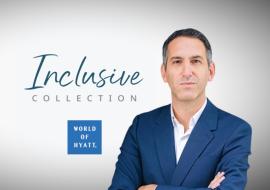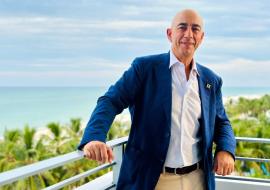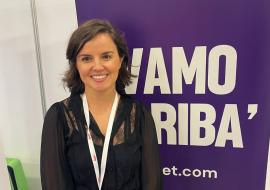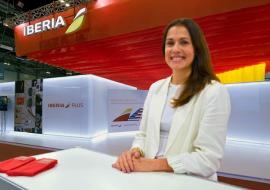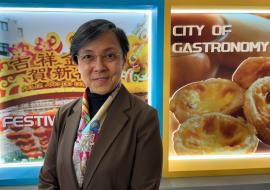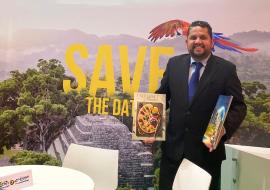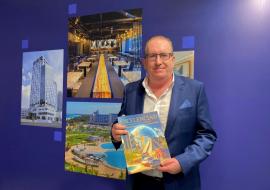Dennis Whitelaw. Chairman of the Puerto Vallarta Hotelier Association
Q: Mr. Whitelaw, what’s the job of the chairman of the Puerto Vallarta Hotelier Association?
A: Be in the frontline of an institution that comprises 54 hotels in Puerto Vallarta. At the same time, we’ve put together a 14-member council that seeks benefits for the association through discount bargaining in products. The council huddles quite often with different tourist sectors, and even with the government to share our needs with it. We account for 99 percent of Puerto Vallarta’s economy. That’s why we’re stronger than the Trusteeship as a group.
We also focus our interest in the social factor. We mean to support the Puerto Vallarta population through the creation of decent jobs for cabdrivers and students, and this is because of the tremendous importance the leisure industry has for our destination. Besides, another important job is the support we provide to the marketing plans that could be used in advertising this destination. We also support actively the Council for the Tourist Promotion of Mexico.
On the other hand, we’ve got different lines of work. One-star, two-star and three-star hotels, the four-star and five-star professional resorts, and the grand deluxe hotels. Each and every one of them has very different markets. That’s why most of our hotels can present their proposals to the Technical Commission that later on picks up a winner. Our job is to guarantee consensus in the decision-making process. All through last year, for example, Vallarta won lots of prizes because of its safety, cleanness and other attributes. Our mission is to protect those benefits the people here have over other locations. This is no way a manmade destination; we’re a hundred percent one of Mexico’s most representative destinations.
Puerto Vallarta grew roots as a town of Mexican fishermen right in the middle of the tobacco plantations and mineral deposits up in the mountains. We’ve got a major market of Mexican visitors (1.5 million), of cruises (350,000 passengers) and the rest coming from Canada, the U.S. (1.2 million), Central America, South America and Europe. I personally believe it’s very important to invest part of our own budget in future markets, to keep our presence in South America and also in Europe.
Q: Within the social benefit program, has it occurred to you to collaborate with the City Hall to provide residents in Puerto Vallarta with, say, sport facilities?
A: We’ve got a protection program for an area of about 200 acres. Besides being a protected area, the place has a few extra acres for the Conference Center, something we need here in Puerto Vallarta, as a way to create more jobs and open up new markets. In a recent study on the impact of counting on a Conference Center right here in the destination, estimates have it that we could have a significant increase in the number of visitors for this particular segment, around 50,000 nights per room every year.
The second plan has to do with the making of a theme park with an area for the benefit of both the community and the tourists. Finally, we’ve got plans to open sport fields for soccer, tennis and even a public golf course at very affordable prices. There’re over 200,000 residents in Puerto Vallarta and according to estimates, we’re going to be half a million people in 2025. There’ll be some 800,000 people in the entire bay area, so that explains the need to focus on those projects.
Q: The presentation of Puerto Vallarta in Spain was that of a unique destination, but now we’ve noticed there are two well-defined zones. Are you really going to conduct your marketing efforts in the unique-destination format or are you going to hold on to the two-zone criterion?
A: From my personal view, when we talk about a marketing plan, I think both parts seek different markets. Even so, there’s a need to implement common projects and to work in coordination. As far as the Vallarta trademark is concerned, well, we’ve been advertising the destination as Puerto Vallarta for a number of years now. That has given it a name abroad and the name has a value. The plot gets thicker because they use the word Vallarta, but we’re Puerto Vallarta, not Nuevo Vallarta.
Secondly, each of these destinations belongs to different states, and that comes to add fuel to the flames. But definitely we’ve got some common projects. For instance, at the Gala Tourist Tradeshow, we welcome corporate people from wholesaler agencies who want to work the destination as a whole. That means we need to have good synergy to keep on working together in common projects in such a way that there’ll be cooperation and actions we’ll both benefit from.






